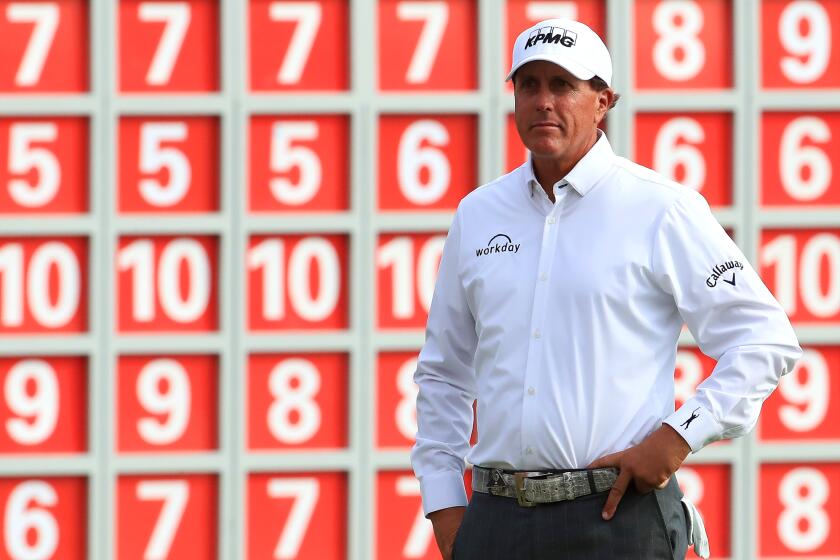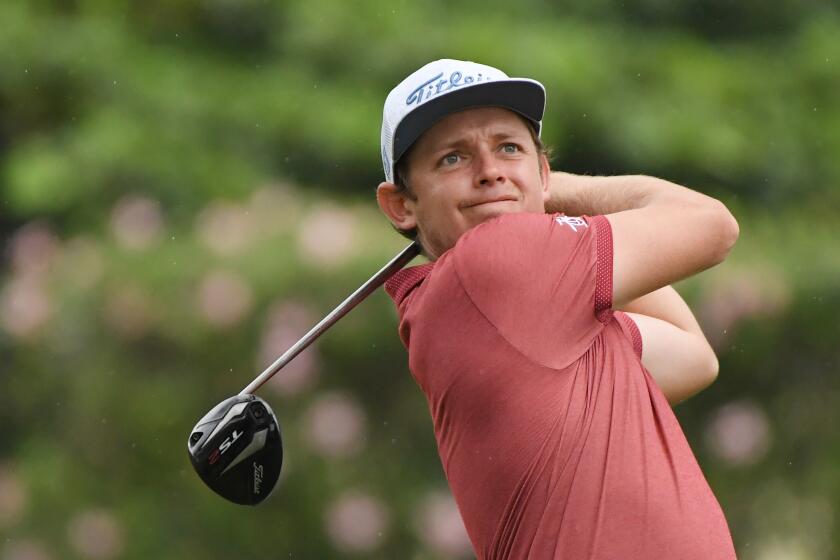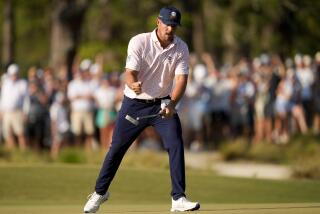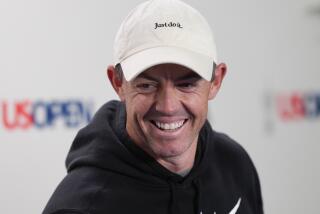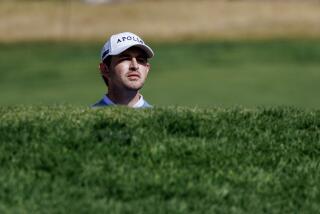Adam Long had to overcome demands of being a PGA champion but struggle made him stronger
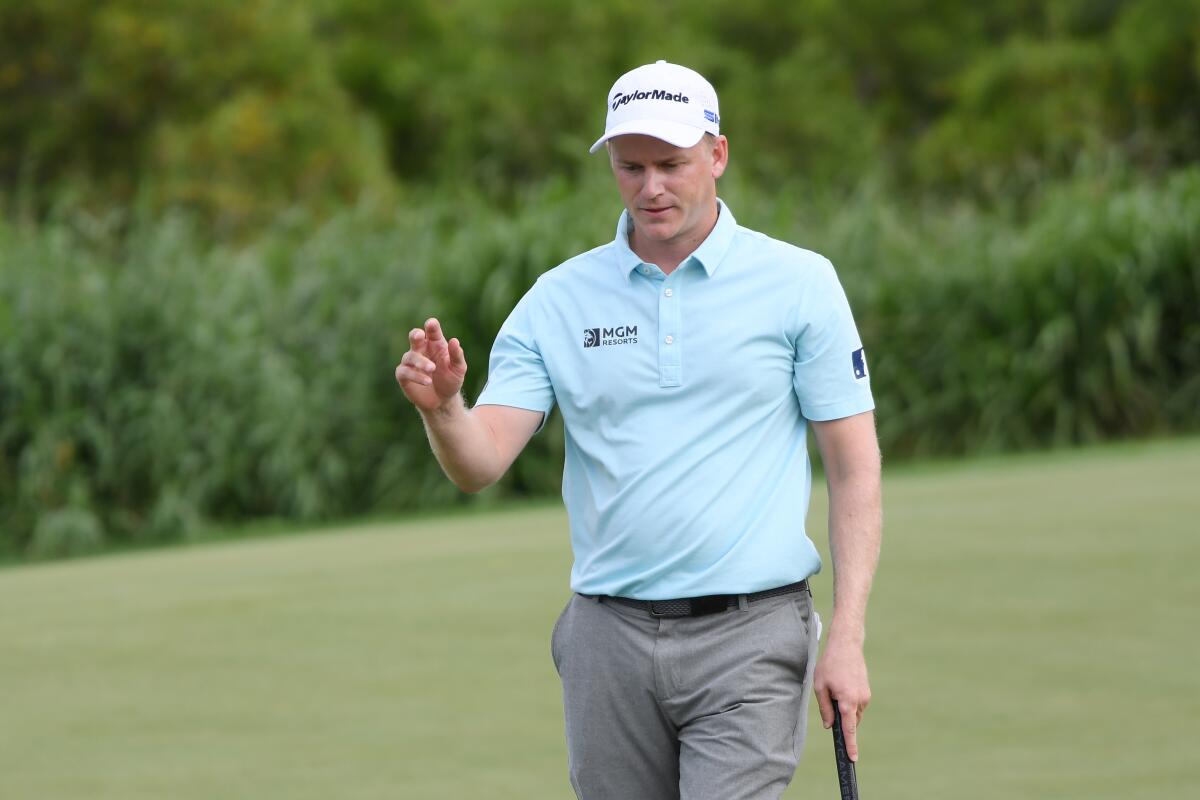
- Share via
The benefits of winning for the first time on the PGA Tour are career changing: an exemption to play on tour for two additional seasons, a seven-figure payday that can take care of a lot of car and mortgage payments, new-found respect from the best players in the world.
But there are also other trappings less expected: rising expectations from others and the player himself, increased demands on time from media and fans, distractions that appear when anonymity vanishes.
Adam Long understands. He was 31 years old and playing in only his sixth PGA Tour event a year ago at what was then called the Desert Classic at the PGA West Stadium Course after years of sometimes fruitless struggles on mini-tours and the Web.Com Tour (now the Korn Ferry Tour).
With a near-miraculous seven-iron from a sidehill lie in the rough and a 14-foot birdie putt on the 72nd hole, Long held off playing partners Phil Mickelson and Adam Hadwin to win what is now known as the American Express and pocket $1.06 million.
But the sense of euphoria that surrounded the 2010 Duke graduate and wife Emily as the desert sun set beyond the Santa Rosa mountains didn’t last forever.
Phil Mickelson turns 50 in June and his plan is to stick with the younger guns on the PGA Tour and leave the senior tour alone for now. And he’s gotten into tip-top shape for 2020.
In fact, Long missed the cut in his next five tournaments, though by only one shot in three of them. Distractions, some self-imposed, played a role.
“When I was missing those cuts, it was like I wanted to validate to myself that it wasn’t a fluke and that I could play out here and it wasn’t a one-hit-wonder kind of thing,” Long said this week at La Quinta as he prepared for the first time in his career to defend a PGA Tour title.
“I felt I put some pressure on myself to do that when I should have just relaxed and played golf like I normally do.”
That was a learning experience for Long, who drew on sessions from years earlier with sports psychologist Bob Rotella who emphasized, in part, trusting one’s self, enjoying the moment and not trying to force things.
“I’d been playing aim-and-shoot all week,” he said of the 26-under-par winning performance in La Quinta. “That week I was just kind of reacting, especially in that moment [on the final hole]. Just trust your game and your instincts and believe in yourself.”

Max Homa was another first-time winner last year whose main takeaway from his victory at the Wells Fargo Championship in May was to continue to emphasize what had worked for him.
“You want to keep that same hunger and drive you had when you were not winning and contending,” said Homa, who had missed the cut in 43 of 68 PGA Tour events in three-plus seasons.
“The thing is, the heat of the battle is addicting and you want to be back there. The biggest thing for me was not getting lackadaisical and continuing to work. ... I try to remember that when I get in the thick of it, I’ve kind of got the innards to get through it.”
Homa has been steady if not spectacular since his win, cashing checks in 13 of 15 events.
For Long, demands from others in the aftermath of his win also were a factor for a player who had never won on the Web.Com Tour and had played in relative obscurity.
“It’s really only what other people put on you,” he said. “You have to learn how you handle being noticed more, the expectations from other people are higher; now you’re supposed to win again ...
“After I won, people told me, ‘Get to the course early every day because a lot of people are going to want to talk to you,’ and that’s true. It’s everyone’s first time to congratulate you or tell you their story about watching you win, and it’s great because you want to hear it. But you walk 10 feet and there’s another story. It can be a lot sometimes, but I’m getting pretty good at it. Of course, it’s a nice problem to have. It means you’ve done something special ...
The victory assures Cameron Smith a spot in the Masters. He also is assured a return to Hawaii next year for the Sentry Tournament of Champions.
“There are times, Monday, Tuesday or Wednesday, when you leave the course and you suddenly realize, wow, I didn’t even chip; I didn’t do those drills I was going to, or whatever. You have to fly by the seat of your pants and adjust a bit.”
After the five missed cuts, Long regained his footing in Bay Hill at the Arnold Palmer Invitational. He finished in a tie for 10th in a strong field and made the cut in half the tournaments the rest of the season in his first trip through the tour schedule.
Then in the fall portion of the 2019-2020 schedule he hit his comfort zone, making the cut in eight straight events with five top-25 finishes, including a tie for second place at the Mayakoba Golf Classic in mid-November. Interestingly, being in his comfort zone doesn’t mean he was comfortable.
“If you want to move up levels in the game, and I still have levels to go, a) you want to get to uncomfortable situations, and b) you want to have success in them,” he said. “And I think embracing that and not being scared of those moments is big, especially for younger guys who haven’t had that experience.
“So being uncomfortable is a good thing; it means you have an opportunity in front of you with a chance to win. That’s what we play for.”
More to Read
Go beyond the scoreboard
Get the latest on L.A.'s teams in the daily Sports Report newsletter.
You may occasionally receive promotional content from the Los Angeles Times.
